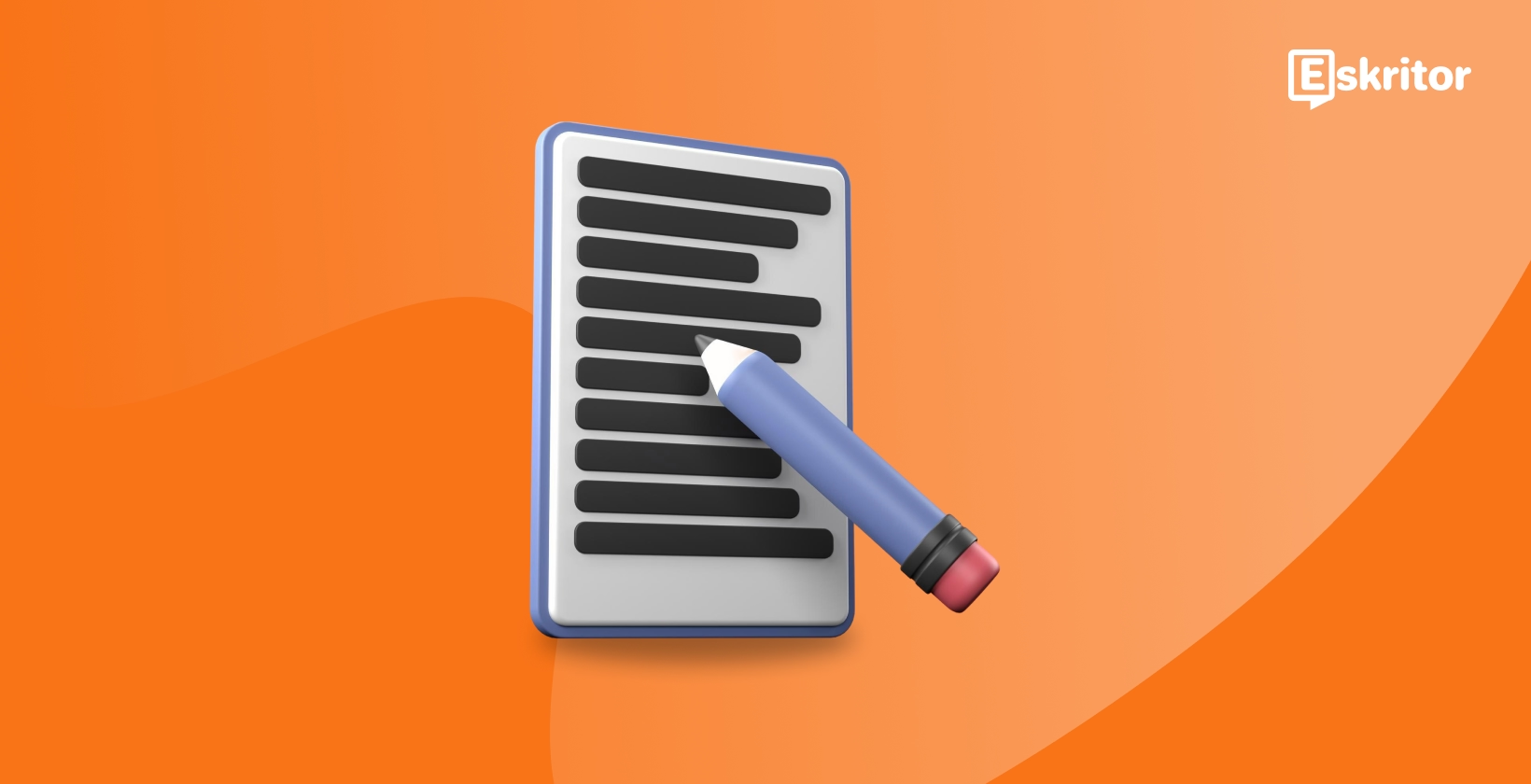
How to Write an Article: Examples & Tips
Generate the Best Content with AI in Seconds
Generate the Best Content with AI in Seconds
Writing an article effectively transforms ordinary content into engaging material that captures audiences' attention instantly. This craft relies on a blend of strategic techniques and proven methodologies that professional content creators apply daily. Studies show that readers form an impression of an article’s quality within just seven seconds, emphasizing how crucial it is to master the art of article writing.
To help you craft compelling content that resonates, consider sentence expansion and here’s a streamlined breakdown of the article writing process:
- Research the topic : Gather reliable information, statistics, and insights from credible sources to build a solid foundation for your article.
- Create an outline : Organize your main ideas and supporting points into a logical structure to guide the writing process.
- Write the introduction : Hook your readers with a strong opening, clearly state the topic, and preview what the article will cover.
- Develop the main body : Present your ideas with clarity, support them with examples, and format content for easy reading.
- Write the conclusion : Summarize key takeaways, reinforce the main message, and encourage the reader to take action.
- Edit and proofread : Review your draft for clarity, accuracy, and flow while fixing grammar, spelling, and formatting issues.
What Are the Fundamentals of Article Writing?

It’s essential to understand the key elements that lay the groundwork for compelling content. These fundamentals help ensure your writing is clear, valuable, and tailored to your audience.
Here are the core components of article writing you need to master:
- Define your purpose and audience
- Choose the right article format
- Include essential structural elements
- Support your points with research and evidence
- Engage readers with tone, flow, and style
How to Define Your Article's Purpose and Audience?
Every successful article begins with clarity about why you're writing and who you're writing for, often guided by a content style guide. This foundational step in article writing determines everything from your tone to the examples you'll include.
The article writing purpose identification process includes:
- Determine whether your article aims to inform, persuade, entertain, or inspire readers
- Create a clear picture of your ideal reader by analyzing demographics, interests, and pain points
- Define the unique value your article will provide to readers seeking information
- List 2-3 specific things you want readers to learn after reading your article
The more specifically you define your target audience for article writing, the more effectively you can address their needs and interests in your article content.
Which Article Type Should You Choose?
Different article formats serve different purposes and meet different reader expectations. Selecting the appropriate article type ensures your content will be structured effectively from the start.
Common article writing formats include:
- How-to guides: Step-by-step instructions for accomplishing specific article writing tasks
- Listicles: Numbered collections of article writing tips or ideas that are easily scannable
- Opinion pieces: Personal perspectives on article writing supported by reasoning and evidence
- News articles: Timely reporting following the inverted pyramid structure
- Case studies: In-depth analyses of specific article writing examples or situations
The article type you choose will influence both your structure and research approach. Select the format that best delivers your message to your specific audience interested in article writing. Additionally, understanding how to summarize articles can enhance your ability to distill complex information into key takeaways.
What Elements Make High-Quality Articles Stand Out?
Understanding what makes articles stand out is crucial for elevating your writing. Certain elements consistently appear in article writing that engage readers and achieve their objectives.
Essential article writing elements include:
- Compelling headlines: Titles that balance curiosity, clarity, and keyword relevance for article writing
- Strong structure: Logical organization with clear transitions between ideas throughout the article
- Supporting evidence: Facts, statistics, and examples that validate your points about article writing
- Engaging writing style: Conversational yet professional tone that matches audience expectations for articles
- Visual elements: Strategic use of images or infographics to enhance understanding of article concepts
The most effective articles balance these elements appropriately for their specific audience and purpose while maintaining focus on quality article writing standards.
How to Write an Article?

Creating high-quality articles follows a systematic process that organizes your thoughts and produces polished content. This step-by-step article writing approach transforms an overwhelming task into manageable activities that lead to professional results.
Research and Gather Information for the Article
Thorough research forms the backbone of credible, valuable articles. Even if you're already knowledgeable about your topic, dedicated research uncovers fresh perspectives and supporting evidence for article writing.
The article research process includes:
- Identify key sources: Collect information from reputable websites, academic journals, and industry experts on article writing
- Take organized notes: Record facts, quotes, and statistics along with their sources
- Look for unique angles: Find perspectives on article writing that aren't commonly covered in similar articles
- Verify information: Cross-check facts across multiple sources to ensure accuracy in your article
The research phase often reveals new directions or important subtopics about article writing you hadn't initially considered, leading to richer content and more comprehensive articles.
Create an Effective Article Outline
A well-structured outline serves as your roadmap for writing articles efficiently. Without this crucial planning step, it's easy to create content that rambles or misses important points about article writing.
Effective article outline creation includes:
- Draft your headline: Create a working title that captures the essence of your article writing topic
- List main sections: Organize your content into logical segments for your H2 headings
- Add subsections: Break down complex article writing topics into smaller parts under H3 headings
- Note key points: Under each section, bullet point the main ideas and supporting evidence for your article
- Arrange for flow: Order your sections to create a natural progression of ideas about article writing
Spend time evaluating your outline before you start writing articles to ensure it addresses all aspects of your topic in a logical order that readers can follow easily.
Writing a Compelling Article Introduction
Your article introduction must hook readers immediately while setting clear expectations. This critical section determines whether readers will continue with your article or click away to find other content.
Effective article introductions include:
- Open with a hook: Use a surprising statistic about article writing, a thought-provoking question, or a bold statement
- Identify the problem: Clearly state the issue or challenge your article addresses for readers
- Establish relevance: Explain why this article writing topic matters to your specific audience
- Preview content: Briefly outline what readers will learn about article writing without giving everything away
While introductions appear first, many experienced writers draft them after completing the body content to ensure the introduction accurately represents the finished article.
Developing the Main Content
The body of your article delivers on the promises made in your introduction. This is where you provide substantive information about article writing that fulfills your article's purpose.
Article body development includes:
- Lead with important information: Start each section with its most crucial point about article writing
- Use examples: Illustrate article writing concepts with real-world examples readers can relate to
- Incorporate variety: Mix sentence lengths and structures to maintain interest throughout the article
- Create scannable content: Use subheadings, bullet points, and short paragraphs for better article readability
- Add transition sentences: Guide readers smoothly between different sections of your article
For each main section, proactively address questions readers might have about that aspect of article writing to make your content more valuable and comprehensive.
Crafting a Strong Conclusion
An effective article conclusion reinforces your main points and leaves a lasting impression. Rather than simply restating what you've written, synthesize the information into final takeaways about article writing.
Effective article conclusions include:
- Summarize key insights: Briefly recap the most important points about article writing without repeating them
- Provide perspective: Place your article writing topic in a broader context or discuss implications
- Include a call-to-action: Suggest a specific next step readers can take after learning about article writing
- End memorably: Close with a powerful statement that reinforces your central theme about effective article creation
A thoughtful conclusion significantly impacts how readers remember and act upon your article content after finishing reading.
Editing and Proofreading
Refining your draft transforms good content into great articles. Effective editing requires looking at your content from different perspectives—both as a writer and as a reader consuming the article content.
The article editing process includes:
- Take a break: Step away from your draft before editing to gain a fresh perspective on your article
- Check content flow: Ensure ideas progress logically and transitions feel natural throughout the article
- Eliminate redundancy: Remove repetitive points or unnecessarily wordy passages from your article
- Verify facts: Double-check all statistics, dates, and factual information included in your article
- Proofread thoroughly: Correct grammar, spelling, and punctuation errors that diminish article quality
Consider asking a colleague to review your article as well. Fresh eyes often catch issues in article writing that the original writer misses during self-editing.
What are the Article Writing Tips?
Once you've mastered the basics, implementing advanced strategies can elevate your content. These article writing techniques help create more engaging, memorable articles that stand out in today's crowded media landscape.
Starting the Article Writing Journey
Beginning writers often struggle with perfectionism and uncertainty. These strategies help overcome initial hurdles and establish productive habits.
- Start small : Begin with shorter articles (500-800 words) to build confidence.
- Focus on topics you know : Write about familiar subjects while developing your skills.
- Study examples : Analyze articles similar to what you want to create.
- Set realistic deadlines : Give yourself appropriate time without endless extensions.
- Seek feedback early : Share drafts with trusted readers to identify improvement areas.
Remember that every professional writer started as a beginner. Consistent practice leads to noticeable improvement over time.
Developing a Writing Routine
Regular practice is essential for skill development. Establishing routines helps overcome procrastination and build momentum in your writing practice.
- Set specific writing times : Schedule dedicated blocks for writing in your calendar.
- Create a conducive environment : Designate a distraction-free space for focused work.
- Start with small targets : Begin with achievable word count or time goals.
- Track progress : Monitor your output and efficiency to identify improvement areas.
- Reward consistency : Develop a system for maintaining your writing schedule.
Consistency matters more than duration. Writing for 30 minutes daily typically yields better results than a single marathon session once a week.
Using Storytelling to Engage Readers
Narrative elements can transform even technical content into compelling reading. The human brain is wired to respond to stories, making storytelling one of the most powerful tools for writers.
- Personal anecdotes : Share relevant experiences that illustrate your points.
- Customer stories : Feature real-world examples of people benefiting from your information.
- Problem-solution narratives : Structure content around challenges and how they were overcome.
- Sensory details : Include descriptive elements that help readers visualize scenarios.
Even in technical articles, brief narrative sections provide context that helps readers understand why the information matters.
Incorporating Data Effectively
Well-presented data adds credibility while making abstract concepts concrete. The key is making that data accessible and meaningful to your specific audience.
- Contextualize statistics : Explain what numbers mean in practical terms.
- Use visual data representation : Consider charts or infographics for complex information.
- Balance numbers with narrative : Avoid overwhelming readers with too many statistics.
- Cite quality sources : Reference respected authorities and recent studies.
Always follow statistics with interpretations that connect the numbers to your main message or reader benefits.
Optimizing Articles for SEO
Strategic optimization helps your article reach its intended audience through search engines. While content quality always comes first, incorporating SEO best practices ensures your valuable content gets discovered.
- Keyword research : Identify relevant search terms your audience uses.
- Natural keyword placement : Incorporate keywords in headlines, subheadings, and throughout content.
- Optimized meta descriptions : Create compelling summaries that encourage clicks.
- Internal and external linking : Connect to relevant content within and outside your website.
The most successful SEO approach balances optimization with readability and user experience.
What Are the Article Writing Tools?
The right tools can significantly enhance your writing efficiency and quality. From article writing software to AI writing assistants for articles, these tools address common challenges while amplifying your natural abilities.
Today's writers have access to specialized tools designed for every stage of the writing process. These solutions can transform your workflow and output quality.
- Research tools : Applications for organizing sources, taking notes, and saving references.
- Grammar checkers : Programs that identify and correct mechanical errors.
- SEO analyzers : Tools that evaluate and suggest improvements for search visibility.
- Readability software : Applications that assess how accessible your content is to readers.
- Collaboration platforms : Systems for sharing drafts and collecting feedback.
For professional article writing, investing in quality tools often pays dividends in both time saved and content quality.
How Eskritor Enhances the Writing Process
Eskritor stands out among article writing tools by offering comprehensive support throughout the content creation journey. This powerful article writing software combines multiple functions in one intuitive platform.

- AI-powered generation : Create first drafts or sections based on simple prompts.
- Smart prompts : Access professionally designed prompts for different article types.
- Editing : Receive suggestions for improving clarity and impact as you write.
- Multiple variations : Generate different versions of headlines or sections.
- Collaboration features : Enable team members to review and comment directly in documents.
Whether you're focused on online article writing or print publications, Eskritor's features address the universal challenges writers face.
Conclusion
Mastering article writing combines fundamental principles with continuous practice, including techniques like AI content generation. By following this step-by-step article writing process, you can significantly improve both the quality and impact of your articles for any purpose.
With tools like Eskritor, an advanced AI writing assistant for articles, you can streamline many aspects of the article writing process, making it easier to write blogposts using AI while maintaining your unique voice and perspective. Whether you're creating article content for a personal blog, professional publication, or business website, these strategies and resources will help you create articles that truly resonate with readers and achieve your specific content goals.
Frequently Asked Questions
The best AI tool for writing articles is Eskritor. It helps you generate high-quality content quickly, build structured outlines, expand your ideas into full articles, and optimize for tone, clarity, and SEO. Eskritor supports multiple languages and works for blog posts, reports, and long-form content.
The ideal article length depends on your purpose, platform, and audience. For blog posts, 1,000-1,500 words typically performs well for SEO while remaining digestible. In-depth guides may run 2,000+ words. Focus on covering your topic thoroughly without unnecessary filler. Eskritor can help adjust content length while maintaining quality.
To overcome writer's block, try techniques like free writing for 10 minutes without editing, starting with an easier section rather than the introduction, changing your environment, talking through your ideas out loud, or breaking your article into smaller, manageable parts. Eskritor's AI assistant can also help generate ideas or draft sections when you're stuck.
Create an effective outline by starting with your main topic and identifying 3-5 key points to become main sections (H2s). Under each main section, add subsections (H3s) that explore specific aspects. Include notes about key information, examples, and data to include in each section. Arrange sections in a logical order that guides readers through your topic naturally.
A compelling introduction hooks readers with an interesting fact, question, or statement, clearly identifies the problem or topic your article addresses, establishes why this matters to your audience, and briefly previews what readers will learn. Keep it concise (3-5 sentences) and make it relevant to the specific audience you're targeting.





 location
location